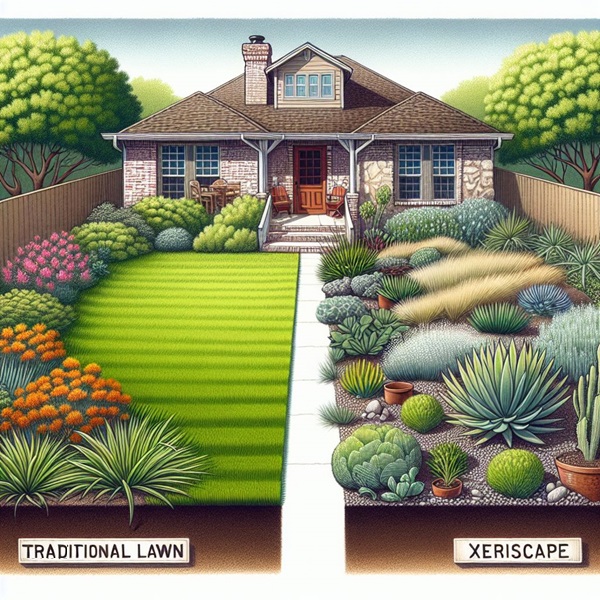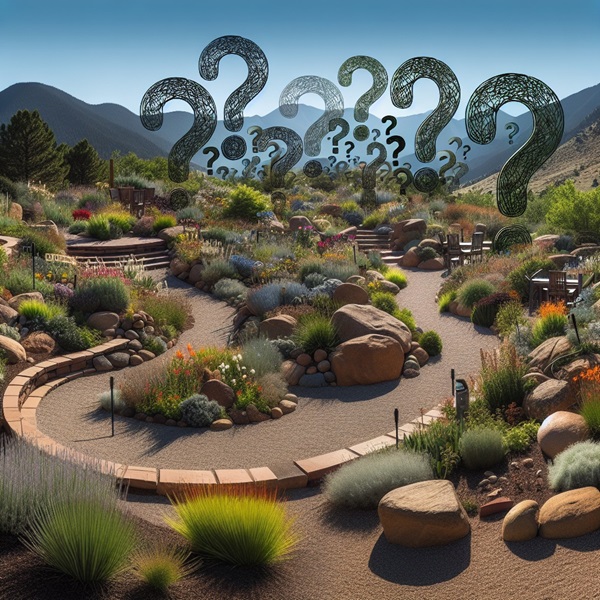
Key Takeaways
- Xeriscaping in Idaho means selecting plants that thrive with little water, like
and Russian sage. - Designing a xeriscape garden involves assessing your space and using principles that highlight natural beauty.
- Efficient irrigation systems, such as drip lines, are crucial for a successful xeriscape.
- Incorporating hardscaping elements like rocks and walkways can reduce water use and add aesthetic appeal.
- Local resources, including Master Gardeners and extension services, can provide valuable guidance for your xeriscape project.
Why Xeriscape?
Imagine your front yard transformed into a lush, vibrant space that’s easy to care for and gentle on the environment. That’s the essence of
The Palette of Plants
Choosing the right plants is like picking out colors for a masterpiece. It’s not just about the water they need; it’s about the harmony they create. In Idaho, you’ll want to look for native plants that are accustomed to the local climate. They’re the ones that will give you a garden that’s both beautiful and resilient.
Planning Your Xeriscape Front Yard
Assessing Your Space
Before you dive into planting, take a good look at your front yard. Where does the sun hit the hardest? Where does the shade linger? Understanding your space is the first step to a xeriscape that looks good all year round. Remember, the goal is to work with nature, not against it.
Design Principles for Maximum Impact
A well-designed xeriscape isn’t just a collection of plants that don’t need much water. It’s a thoughtfully composed landscape that draws the eye and soothes the soul. Here are some principles to keep in mind:
- Group similar plants together: This not only creates visual impact but also simplifies watering.
- Use texture and color: Play with different plant textures and hues to add depth and interest.
- Consider the future: Think about how your plants will grow over time and plan for the space they’ll need.
Flowers and Shrubs for Idaho Climates
Drought-Resistant Flower Favorites
When it comes to flowers, Idaho’s climate calls for species that can handle a little neglect when the rain forgets to fall. Think of flowers like the vibrant blanket flower with its fiery red and yellow petals, or the serene blue flax that waves gently in the breeze. These aren’t just pretty faces; they’re survivors, adapted to thrive with minimal water.
Shrubs That Stand Strong
Shrubs are the backbone of any xeriscape. They provide structure and a year-round presence. In Idaho, you’ll want to lean on tough characters like the Russian sage, with its silvery foliage and spires of purple flowers, or the sturdy sumac, which can dazzle with fiery autumn colors. These shrubs don’t just survive; they flourish with the right care.
Water-Saving Techniques and Irrigation
Water is precious, especially in a xeriscape. The secret to success here is getting the most out of every drop. That’s where smart irrigation comes into play. Drip irrigation systems are a game-changer, delivering water right to the roots of your plants, where it’s needed most. And timers? They’re not just convenient; they’re a way to ensure you’re not over or under-watering.
Efficient Watering Systems
Efficient watering systems are the lifeline of a thriving xeriscape. These systems can range from simple soaker hoses snaked through your garden beds to more sophisticated drip lines that can be adjusted for each plant’s needs. The key is to deliver water where it counts and cut down on evaporation.
Utilizing Mulches and Ground Covers
Don’t underestimate the power of mulch. It’s like a cozy blanket for your soil, keeping it cool and moist. Ground covers, too, play a double role. They’re living mulches that add beauty while they protect and nourish the soil. Plants like creeping thyme can create a lush carpet that chokes out weeds and saves water at the same time.
Complementing Your Plants with Hardscaping
Selecting Materials That Enhance Your Xeriscape
Hardscaping is more than just a pretty face for your garden. It’s about choosing materials that complement your plants and reduce your water needs. Gravel and stone are not just durable; they reflect heat, minimize water loss, and add texture to your garden. And when you choose local materials, you’re reducing your carbon footprint, too.
Walkways and Patios: Functional Beauty
Walkways and patios aren’t just paths and places; they’re opportunities to reduce your lawn size and water usage. Pavers and flagstones can create inviting spaces that invite you to linger in your garden, all while reducing the need for thirsty grass.

Local Guidelines and Resources
Understanding Idaho’s Xeriscaping Laws
Before you start digging, it’s wise to get to know the local xeriscaping laws. Some areas may have restrictions on the types of plants you can use or require certain irrigation practices. It’s always better to be in the know than to find out after the fact.
Finding Grants and Incentives for Xeriscaping
Did you know that some local governments and water utilities offer incentives for xeriscaping? These can range from rebates for installing efficient irrigation systems to free xeriscape design workshops. It’s worth a look to see what’s available in your area.
Community Impact and Ecological Benefits
Neighborhood Appeal and Environmental Responsibility
A xeriscape does more than just save water; it sets an example. It shows your neighbors that beauty and sustainability can go hand in hand. And as more people embrace these practices, the benefits ripple out, leading to healthier communities and ecosystems.
Wildlife-Friendly Practices
By choosing the right plants and minimizing chemical use, your xeriscape can become a haven for local wildlife. Birds, bees, and butterflies all benefit from the habitat you’re creating. And isn’t it a joy to see them visit? Your garden becomes a living, breathing space that supports life beyond just the plants.
By choosing the right plants and minimizing chemical use, your xeriscape can become a haven for local wildlife. Birds, bees, and butterflies all benefit from the habitat you’re creating. And isn’t it a joy to see them visit? Your garden becomes a living, breathing space that supports life beyond just the plants.
Creating Your Xeriscape Step-by-Step
Now, let’s roll up our sleeves and dig into the nitty-gritty of creating your xeriscape. It’s a journey of transformation, and every step you take brings you closer to a garden that’s both gorgeous and water-wise.
First things first, sketch out your vision. Grab some paper and draw a rough outline of your front yard. Mark out where the sun beats down the fiercest and where shadows linger. This will help you decide where to place those sun-loving plants and where the shade-dwellers will be happiest. Remember, a good plan is the foundation of a great garden.
Next, it’s time to get down and dirty with soil preparation. Idaho soil can be a mixed bag, so you might need to amend it to get the best results. Adding organic matter can improve soil structure and water retention, making it a cozy home for your plants’ roots.
Starting with a Vision
Your xeriscape starts with a dream. Picture the colors, textures, and shapes you want to see outside your window. Imagine the scents on the breeze and the sound of birds that come to visit. This vision will guide every decision you make, from plant selection to the path of your garden walkway.
Implementation: From Paper to Soil
With a plan in hand, it’s time to bring your vision to life. Begin by marking out the areas for planting and hardscaping. Choose your plants according to your design principles, and remember to group them by their water needs. As you plant, give each one the space it needs to grow and thrive. Then, install your irrigation system, lay down mulch, and step back to watch your xeriscape come alive.
| Design Idea | Flowers & Shrubs Used |
|---|---|
| 1. Desert Oasis | Lavender, Russian Sage, Agastache, Yucca, Penstemon |
| 2. Water-Wise Wonderland | Coneflowers, Black-Eyed Susans, Blue Fescue, Junipers |
| 3. Drought-Tolerant Delight | Sedum, Ice Plant, Dwarf Pines, Butterfly Bush, Daylilies |
| 4. Low-Maintenance Marvel | Sage, Dwarf Alberta Spruce, Creeping Phlox, Catmint |
| 5. Mountain Retreat | Columbines, Blue Spruce, Shasta Daisies, Dwarf Lilacs |
References
1 https://waterthriftyplants.com/xeriscaping/
2 https://www.xericgardening.com/about-us
3 https://uslawns.com/locations/id/boise/services/irrigation/xeriscaping/
4 https://www.fs.usda.gov/database/feis/plants/shrub/artcan/all.html
5 https://xeriscapeswan.com/colorado-xeriscape-law-legal-lawn-removal-guide-tips/

Frequently Asked Questions (FAQ)
Can I have a xeriscape with lots of color?
Absolutely! Xeriscaping doesn’t mean you’re stuck with a dull garden. There are plenty of drought-resistant plants that burst with color. Blanket flowers,
How do I select the right plants for my region in Idaho?
Choosing the right plants is key to a successful xeriscape. Look for native species or those adapted to Idaho’s climate. Visit local nurseries, consult with Master Gardeners, or check resources from the University of Idaho Extension for guidance.
Are there any rebates for xeriscaping in Idaho?
Yes, some local utilities and municipalities offer rebates and incentives for water-wise landscaping. Check with your local water provider or city government to see what programs are available in your area.
How much maintenance does a xeriscape yard require?
Once established, a xeriscape yard requires significantly less maintenance than a traditional lawn. You’ll spend less time mowing, watering, and fertilizing, and more time enjoying your beautiful, sustainable garden.
Can xeriscaping increase my property value?
Indeed, xeriscaping can enhance your property’s curb appeal and potentially increase its value. A well-designed xeriscape signals to potential buyers that your home is eco-friendly and comes with the bonus of lower water bills and maintenance costs.
Idaho’s climate is well-suited for xeriscaping, a landscaping method that reduces or eliminates the need for supplemental water from irrigation. It’s an ideal strategy for creating an easy-care front yard that conserves water and thrives in the region’s semi-arid conditions. By incorporating native flowers and shrubs, homeowners can enjoy a vibrant, sustainable garden.




Leave a Reply